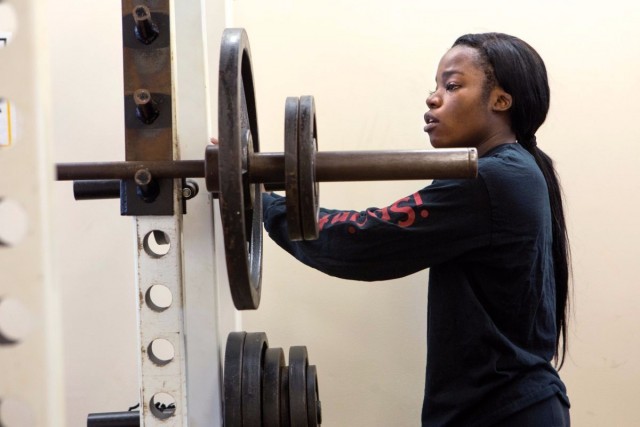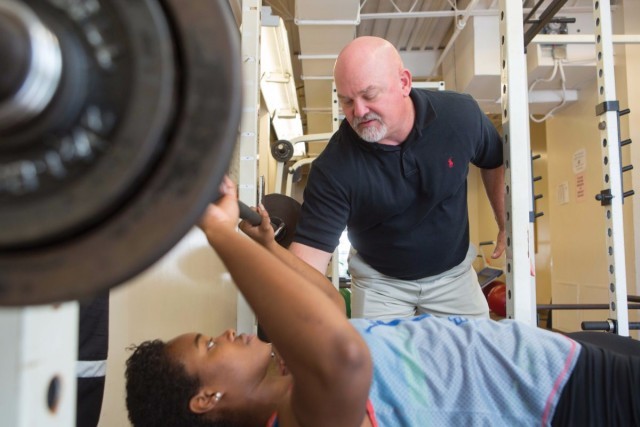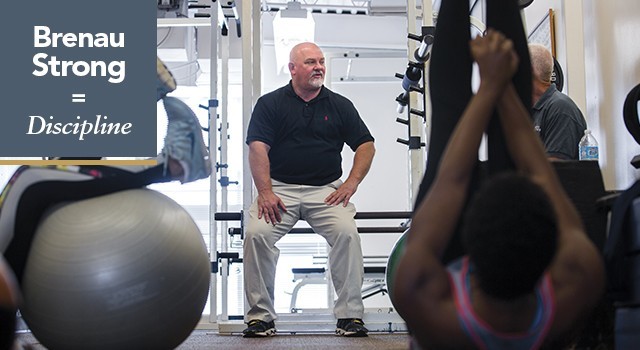Body of Work
A legendary football coach once said that success follows speed. Brenau’s intercollegiate athletes have discovered that good old-fashioned muscle also plays into that equation.
At the gym, Lammy Sokunbi, batting spiky eyelash extensions and wearing a flashy headband that restrains an elaborate coil of hair, looks primped just right for her major – fashion design – and picture perfect for work in an atelier, where she hopes to land after graduation.
At 5 feet 2 inches tall and just under 110 pounds in her unitard, she cuts a sleek, femme silhouette that no one would ever mistake for that of an NFL linebacker. Facing an imposing stack of plastic containers, she squares her stance, looks at her trainer, Gary Hatfield, and says, “You got me, right, coach?”
“Be explosive!” the coach replies.
With that, she springs, flat-footed, up on a box that stands 36 inches tall – higher than her waspish waistline but still lower than her personal-best freestanding vertical jump record of 48 inches. She lands with perfect balance. In that one fast, feline move, she demonstrates why Brenau’s athletes are called Tigers.
Sokunbi, a senior from Marietta, Georgia, reigns in track and field, where she has completed a triple jump of 11.6 meters, or slightly more than 38 feet, and her 100-meter sprint clocks in at 11.7 seconds. Her squats? She can hoist 350 pounds with those tensile hamstrings, which have carried her to eighth position in the All-Americans of National Association of Intercollegiate Athletics sprinter. She is expected to ascend to the top three this year. Sokunbi did not slack off in her exercise regimen over the summer, the way some jocks do.
“Lammy is, pound for pound, our strongest athlete,” Hatfield says, “and you can see that all that weight-lifting has not made her look like a guy.”
Hatfield has been battling a misperception for a long time that any woman hoisting a barbell or two will morph her into a female version of “The Incredible Hulk.” “I have to do a lot of myth-busting,” he says, shaking his head, “starting with ‘girls will look like guys,’ or ‘girls can’t do this or that.’ First of all, ‘can’t’ is a word we simply don’t use around here. Girls can out-squat, out-run and out-lift the guys – without ever looking like guys. I can’t stress that enough. That’s not how nature and hormone balances work. If a woman starts to look masculine, you’ll notice that her voice will drop lower. All of that is a sign that she’s doing something she shouldn’t,” he says, hinting darkly at steroid use. “Weight-training will make the average young woman look fit and healthy, not masculine.”
Hatfield, 58, shown in the photograph above, does look like an NFL linebacker. The retired firefighter serves as fitness center director, assistant varsity softball coach and head coach for the new JV softball team. However, his defining contribution to Brenau has been developing a program of rigorous strength training for all campus athletes – and all means everybody from cheerleaders to golfers to shot-putters – in addition to their regular practice sessions. “I train men and women the same,” Hatfield says. “The biomechanics of the body are the same.”
“It’s unusual for smaller colleges and universities to hire someone specifically to develop a program of strength training,” says Kristin Gillette, a spokeswoman for the NAIA. “I think an institution dedicating resources for a strength and conditioning coach shows real commitment to the improvement of student-athlete performance and development.”
All of that sweat equity is also paying dividends for the trophy mantel. If you have tracked the booming growth and progress of Brenau’s athletic program for the past few years, you will have noticed a great many victory dances on the fields, courts and poolside. The softball team went from winning only two games in one season to garnering no fewer than 30 wins every season, and it just marked its 300th triumph on the field, while the track team has been the Southern States Athletic Conference champ for the past three years.
“When I started my job in 2008,” says Athletics Director and Soccer Coach Mike Lochstampfor, “I saw a need for strength training for two reasons. Obviously, it helps us to be more competitive and perform at a much higher level, but more important to me is that it serves as a preventive for injuries.”
Adds Cheer Coach Krista Britt, “It is important that our athletes stay strong to be able to execute the level of skills needed to maintain our top national ranking. Having a strong core and lower body decreases the probability of injury, as well. Our athletes do strength training three times a week to stay healthy, strong and competitive.”
For example, the anterior cruciate ligament, or ACL, is one of four ligaments that help stabilize the knee. It’s also often the first tissue to contract injury. Women have a different knee-to-hip angle than men, so they are more vulnerable to sports injuries in that body region, especially in activities such as soccer. Strength training keeps that area more nimble and resilient.
“We want to make sure our women are healthy while they’re here,” Lochstampfor says, “but we also hope that 10 or 20 years from now they won’t experience problems with their joints because of an old sports injury.”

Enter Hatfield, who is ranked among the top top 10 weight lifters in the world in his age group. The father and coach of two athletic daughters, one of whom (Chelsey), attended Brenau, he started at the university as a volunteer – someone who just wanted to use his expertise to foster greater physical fitness wherever he could. That role grew into a part-time position and then into his current job, which mixes administration, physical science and motivational speaking. One of his favorite coach-speak buzzwords, as he used to motivate Sokumbi, is “explosive.”
“Power is mass times distance divided by time,” he says. “Sports is moving mass through space with speed. The more explosive you are, the more power you have. For example, with Lammy, it’s not just that her legs are turning over faster; it’s that when her foot hits the ground, she’s pulling more ground behind her. If we can increase her stride by just two inches, with enough feet, that will add up to 100 inches. Similarly, in softball, all those inches add up when you’re running for bases and hitting a ball.”
Strength training is a relatively new priority for athletic programs. “In my lifetime, I’ve gone from watching girls relegated to playing half-court in basketball to full court,” Hatfield marvels. He notes that Russian scientists were the first to emphasize weight lifting in double-blind studies on muscle contractions. “They brought their science here, and we realized some of our methods were outdated,” he says. “There was a myth that weight lifting would make a basketball player too stiff, when that isn’t true. We finally have started to catch up with them. There’s a direct link between strength and throwing farther, whether it’s a basketball, a softball or a javelin.”
Senior health sciences major Kelly Cohron of Buford, Georgia, took a break from helping out in a Red Cross blood drive on the Gainesville campus in November to talk about how Hatfield’s program has affected her game as a member of the Golden Tigers No. 10 nationally ranked tennis team. “It builds your legs and I don’t get as tired,” she says. “And it helps my serve, too. I think I’m hitting the ball much harder since I started working out.”
Sokunbi ran track in high school but did not lift weights then.
“It’s opened up a whole new world for me,” she says. “Coach pushes you outside your comfort zone into stuff you didn’t think you could do. I like Brenau because it’s a student-athlete environment, meaning the ‘student’ part comes first. Our training never interferes with our studies, and at some schools, it’s the other way around. Coach is tough, but he’s encouraging. I’m doing things now I never would’ve imagined.”


